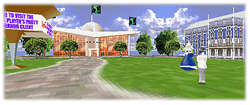
Open Communities the shared space technologies being led by MERL with the SPLINE environment, is the basis of the experimental community called Learning Works. LearningWorks (slide show) is an environment for the delivery of educational courses. It's based on the Smalltalk language and development of curriculum is performed by using a Smalltalk based graphics interface. Smalltalk is the original object oriented language pioneered in the 70's by the good people at Xerox PARC.
Starbright World created by the Starbright Foundation and led by Steven Spielberg and General H. Norman Schwarzkopf exists to give seriously ill children in hospitals a virtual environment to escape their daily ordeals. Although based on proprietary solutions with high speed networks, this virtual community points to truly valuable uses for all these whiz bang technologies. To quote from Spielberg's vision, "…We can give them a place where their imaginations can run free… it's not just about entertainment; it's unleashing the power of entertainment and emerging technologies to develop new tools to help these kids heal."
Another big player in the multi-user development area is Sony. Their Virtual Society on the Web, site has the Community Place browser and a wide variety of multi-user worlds. The multi-user server is called Community Place Bureau. They provide tools and guidelines to develop shared worlds and build avatars. Sony, to its credit, supports the VRML effort and community and has made major contributions to the development of open standards. Personally I can't wait till a multi-user VRML browser appears for a Playstation.
Perhaps the most accessible and readily available tools for building shared collaborative environments are available from blaxxun interactive. Formerly known as Black Sun Interactive the blaxxun folks offer a robust suite of tools for building virtual worlds with avatars and bots. The bots are 3D characters with a small amount of automated intelligence (programmed via a bot language) and can automatically greets entering guests, give product demonstrations or answer questions, in a limited way. For example a you can interact with a bot called Kate by typing in the chat box, "Kate: where is the bathroom". To which Kate responds "I'll have a life one day, sandy, but for now I live and work here." In blaxxun's main world (vrml link) there are a few bots that say hello, but my favorite is a Black & Decker Dustbuster (hand held vacuum) called Dusty. You can ask Dusty for help and it literally flies up and asks if you want product information. Imagine a world where advertising products physically compete for your attention by shoving each other around for your attention! From a development point of view, you can set up a virtual environment and manage users, chatting, bots, 3D environments, shared persistent objects and deal with firewalls.
Let's all get out there and start shoveling some virtual dirt!
Previous
Features